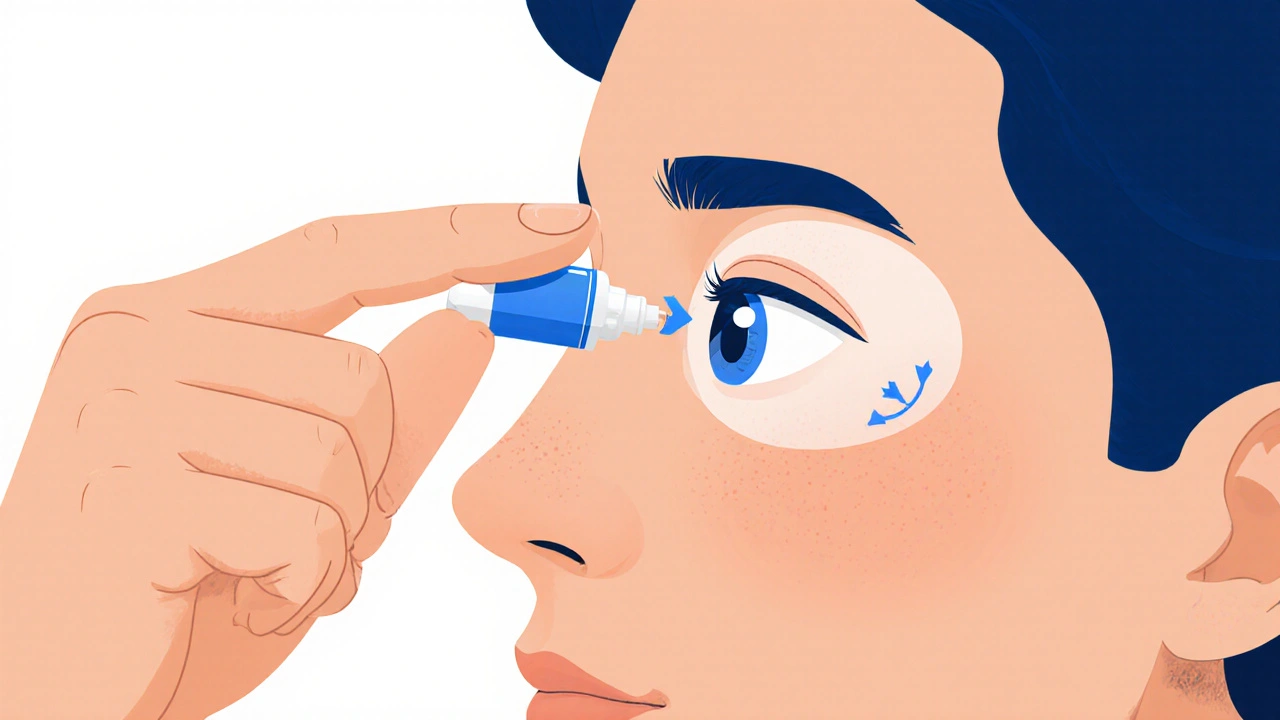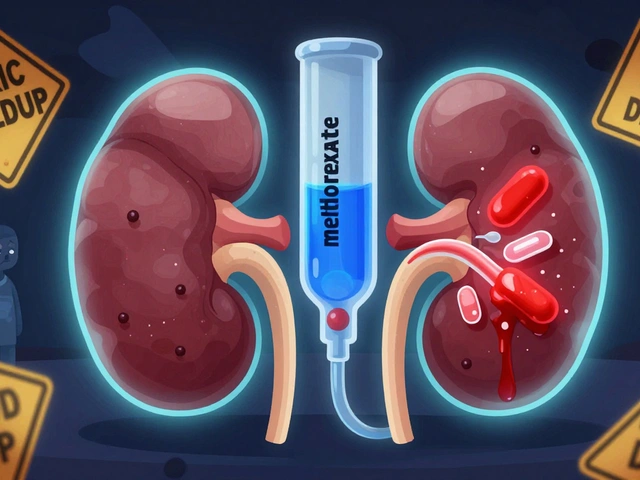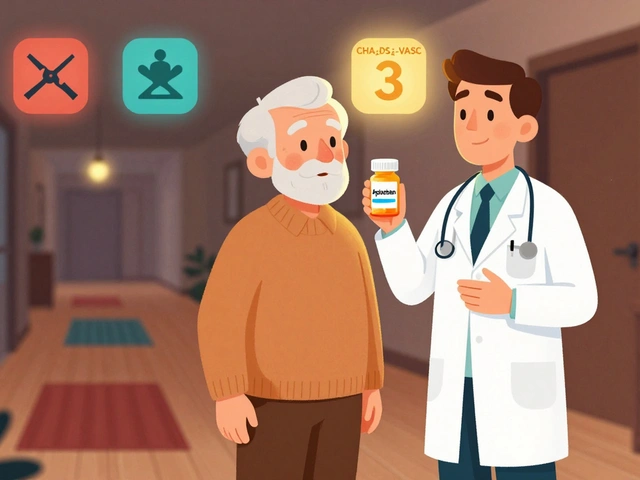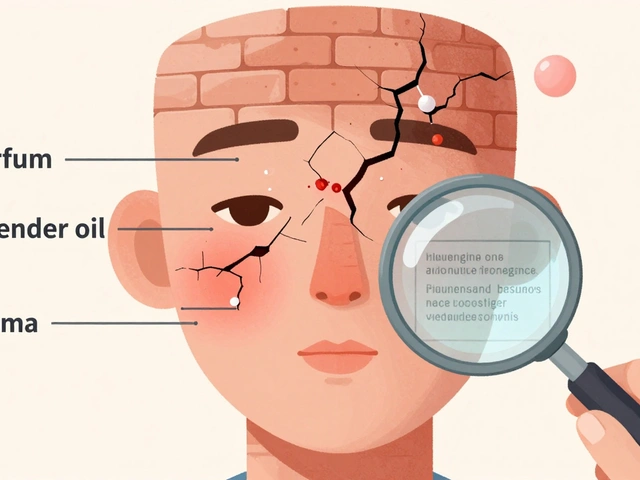
Bringing your eyes into focus doesn’t always mean clearer vision-it can also mean dryness, redness, or even dizziness. If you’re using brimonidine tartrate eye drops for glaucoma or ocular hypertension, you’re likely familiar with these uncomfortable moments. The good news? Most side effects are mild, temporary, and manageable with simple adjustments. You don’t have to just tolerate them. Here’s how to reduce or prevent the most common ones-based on real patient experiences and clinical guidelines.
Understand how brimonidine tartrate works
Brimonidine tartrate is a selective alpha-2 adrenergic agonist. It lowers eye pressure by reducing how much fluid your eye produces and helping it drain better. It’s usually prescribed as a 0.1% or 0.2% solution, applied once or twice daily. While it’s effective at protecting your vision, it doesn’t stay locked in your eye. About 30% of the dose gets absorbed through the tear ducts into your bloodstream. That’s why side effects aren’t just local-they can affect your whole body.
Most common side effects and how to handle them
Over half of users report at least one side effect in the first few weeks. The most frequent ones are:
- Dry mouth
- Burning or stinging after application
- Red or itchy eyes
- Feeling tired or drowsy
- Headache
- Blurred vision
These aren’t dangerous, but they can make daily life harder. Here’s how to cut them down.
Use the punctal occlusion trick
One of the biggest reasons you feel side effects like drowsiness or dry mouth is that the drops drain into your nose and throat. You can block that path with a simple trick: after you put in the drop, gently press your finger on the inner corner of your eye-right where the eyelid meets your nose-for a full 60 seconds. This closes off the tear duct and keeps the medicine where it belongs.
Studies show this reduces systemic absorption by up to 80%. That means fewer headaches, less fatigue, and less dry mouth. Do this every time. It takes less than a minute, and it’s the single most effective way to prevent side effects without changing your dose.
Apply drops at the right time
If you feel drowsy after using brimonidine, don’t wait until you’re behind the wheel or operating machinery. Most people notice sleepiness within 30 to 60 minutes after application. Schedule your second dose for the evening, right before bed. That way, the drowsiness works for you instead of against you.
Also, avoid applying drops right before a meeting, driving, or any task that needs sharp focus. Give yourself 20 minutes to let your vision clear up after each drop. Blurred vision usually fades on its own, but it’s worse if you blink too much or rub your eyes.
Keep your eyes moist
Bringing down eye pressure also brings down tear production. Dry eyes are the #1 complaint among users. If your eyes feel gritty or sore, reach for preservative-free artificial tears. Don’t use regular over-the-counter drops that contain benzalkonium chloride-it can irritate your eyes more when combined with brimonidine.
Look for brands labeled “preservative-free” and use them at least 5 minutes after your brimonidine dose. Waiting helps prevent the drops from washing out your medication. You can use them as often as needed-dryness doesn’t mean you’re doing something wrong.

Watch for allergic reactions
Red, swollen, or itchy eyes might just be irritation-or they could be an allergy. About 1 in 20 users develop eyelid swelling or conjunctivitis. If your eyes get worse after a few days instead of better, stop the drops and contact your doctor. Don’t wait for it to get worse.
Signs of an allergic reaction include:
- Swelling of eyelids or around the eyes
- Severe itching that doesn’t improve with artificial tears
- Increased redness or discharge
Switching to another glaucoma medication like latanoprost or timolol may be necessary. Your doctor can help you choose one that won’t trigger the same reaction.
Don’t mix with other medications
Brimonidine can interact with drugs that affect your nervous system. If you take antidepressants like SSRIs (e.g., sertraline, fluoxetine), MAO inhibitors, or blood pressure meds like clonidine, you’re at higher risk for low blood pressure, slow heart rate, or extreme drowsiness.
Always tell your doctor about every medication you take-even over-the-counter ones. Cold medicines with pseudoephedrine or decongestants can raise your eye pressure and counteract brimonidine. Herbal supplements like St. John’s wort can also interfere with how your body processes it.
Store and handle drops properly
Brimonidine is sensitive to heat and light. If you leave your bottle on the bathroom counter near the shower, it can break down faster. That means less effective medicine and more irritation from degraded ingredients.
Keep it in the fridge after opening. Most bottles are good for 6 weeks once opened. Check the expiration date on the label. If the liquid looks cloudy, changes color, or has particles in it-throw it out. Don’t risk eye damage from contaminated drops.
Children and older adults need special care
Brimonidine isn’t approved for children under 2, and it’s used with caution in older adults. In seniors, side effects like dizziness and low blood pressure are more common. If you’re over 65 and feel faint after using the drops, sit down. Get up slowly. Ask your doctor if a lower dose (0.1%) is right for you.
For kids, even a tiny drop can cause serious side effects like low body temperature or breathing trouble. Always keep the bottle out of reach. Use a clean tissue to wipe any excess around the eye-never let a child touch the dropper tip.

When to call your doctor
Most side effects fade within 2-4 weeks as your body adjusts. But if you experience any of these, contact your eye doctor right away:
- Severe eye pain or sudden vision loss
- Chest pain, slow heartbeat, or fainting
- Difficulty breathing or swelling of the face, lips, or tongue
- Depression, hallucinations, or unusual thoughts
These are rare, but they need immediate attention. Brimonidine isn’t safe for people with severe heart disease, low blood pressure, or certain mental health conditions. Your doctor should have screened you for these before prescribing it.
Alternatives if side effects don’t improve
If you’ve tried all the tips and still can’t tolerate brimonidine, there are other options. Prostaglandin analogs like latanoprost or travoprost are often better tolerated-they cause less drowsiness and dry mouth. Beta-blockers like timolol work well too, but they can cause breathing issues in people with asthma.
Your doctor may suggest switching to a combination drop like brimonidine/timolol (Combigan) to reduce the number of bottles you use. That also cuts down on the total amount of preservatives hitting your eye.
For people who hate daily drops, laser treatments like SLT (selective laser trabeculoplasty) can reduce pressure without medication. It’s not a cure, but it can delay or even replace the need for eye drops in some cases.
Track your symptoms
Keep a simple log: write down what side effects you get, when they happen, and how bad they are. Note if they improve after a week or get worse. Bring this to your next appointment. It helps your doctor decide whether to adjust your dose, switch medications, or add something like artificial tears.
Some patients find that using a phone reminder app helps them stick to the schedule and avoid doubling up. Missed doses can cause pressure spikes, which is worse than side effects.
Final thought: You’re not alone
Glaucoma treatment is a long game. Brimonidine works, but it’s not perfect. Millions of people use it and find ways to make it manageable. You don’t have to suffer through side effects to protect your sight. Small changes-like punctal occlusion, timing your doses, and using the right artificial tears-can make a huge difference.
Stay consistent. Stay informed. And don’t hesitate to speak up if something doesn’t feel right. Your vision matters. So does your comfort.
Can brimonidine tartrate cause low blood pressure?
Yes, brimonidine can lower blood pressure, especially in older adults or people already on blood pressure medications. It’s more likely if you take it with other drugs that affect the nervous system, like clonidine or certain antidepressants. If you feel dizzy, lightheaded, or faint after using the drops, sit down and check your blood pressure. Talk to your doctor if this happens regularly.
How long do side effects last?
Most mild side effects-like dry mouth, stinging, or tiredness-improve within 1 to 4 weeks as your body adjusts. If they get worse or don’t improve after a month, it’s time to talk to your doctor. Persistent redness, swelling, or vision changes aren’t normal and may signal an allergy or other issue.
Can I use brimonidine with contact lenses?
Remove your contacts before applying brimonidine. Wait at least 15 minutes after the drop before putting them back in. The preservatives in the solution can stick to the lenses and irritate your eyes. If you wear contacts daily, ask your doctor about preservative-free brimonidine formulations-they’re less likely to cause discomfort.
Is it safe to use brimonidine during pregnancy?
There isn’t enough data to say brimonidine is completely safe during pregnancy. Animal studies showed harm to fetuses at high doses. If you’re pregnant or planning to be, talk to your doctor. They may switch you to a safer alternative like timolol or latanoprost, which have more safety data in pregnancy.
What happens if I miss a dose?
If you miss a dose, take it as soon as you remember-but only if it’s not close to your next scheduled dose. Never double up to make up for a missed one. Missing doses can cause your eye pressure to rise, which increases your risk of vision damage. Set a daily alarm or use a pill organizer to stay on track.






15 Comments
Just started brimonidine last week and the punctal occlusion trick changed everything. No more drowsiness at work. I was ready to quit until my optometrist mentioned this. Do it every time. Seriously. It’s like a secret hack.
Let me tell you, I’ve been on this med for three years. Dry mouth? Use a saliva substitute like Biotene. Blurry vision? Don’t blink right after applying-wait five seconds. And yes, refrigerate the bottle. I learned the hard way when I left mine in the car and it turned cloudy. Eye damage isn’t worth saving a few bucks on a new bottle.
Also, if you wear contacts, remove them. I used to ignore this and ended up with a corneal abrasion. Not fun. Your eyes are already stressed-don’t add insult to injury.
And for the love of god, don’t mix this with SSRIs without telling your doctor. I had a friend who took Zoloft and brimonidine together and nearly passed out driving. It’s not a joke.
Track your symptoms. I use a Google Sheet. Time of day, side effects, pressure reading if you have a home monitor. It helps your doc see patterns. I went from twice daily to once daily because my logs showed my pressure was stable after morning dose alone.
And yes, preservative-free tears are non-negotiable. I use Thealoz Duo. No stinging. No burning. Just relief. Avoid anything with BAK. It’s like pouring salt in a wound.
Don’t let the fear of side effects stop you. Glaucoma steals your sight silently. This med? It’s a shield. Minor discomfort now beats blindness later.
One more thing: if you’re over 65, start with 0.1%. Lower dose, same protection, fewer crashes. My dad switched and suddenly he wasn’t falling asleep in his recliner anymore.
You’re not alone. Millions of us are doing this. You got this.
They don’t want you to know this but brimonidine is basically a slow-acting beta-blocker disguised as a glaucoma drop-pharma’s way of keeping you hooked while they patent the next version. That drowsiness? That’s your CNS being suppressed. And don’t get me started on the refrigeration requirement-why? So they can control supply? They know people won’t bother. That’s why side effects stay high. It’s not incompetence-it’s design.
And the ‘punctal occlusion’? A Band-Aid on a bullet wound. They’re not fixing the problem-they’re just teaching you to suffer better.
I’ve been on this for 8 years. The first month was rough-dry mouth, tired all the time. But I stuck with it because I’ve seen what glaucoma does to my grandma’s eyes. The punctal occlusion? Game changer. I do it without thinking now. It’s like brushing your teeth.
Also, I use the 0.1% version. Less intense, still works. My doc said it’s fine for long-term use if your pressure’s stable.
And yeah, avoid cold meds with pseudoephedrine. I learned that the hard way after a sinus infection. My pressure spiked. Not worth it.
You’re not crazy for feeling weird. You’re just adapting.
From a clinical pharmacology standpoint, the systemic absorption profile of brimonidine is mediated by alpha-2 receptor agonism in the CNS and peripheral vasculature, which explains the hypotensive and sedative effects. The punctal occlusion technique reduces bioavailability via the nasolacrimal duct, thereby attenuating Cmax and AUC. This is well-documented in Phase IV post-marketing surveillance studies. Furthermore, concomitant SSRI use may potentiate serotoninergic modulation of noradrenergic pathways, increasing the risk of bradycardia and hypotension. Preservative-free formulations are indicated in patients with pre-existing ocular surface disease due to reduced epithelial toxicity. Always confirm concomitant medication reconciliation prior to initiation.
I hate this drug. I cried the first week. My eyes burned like I’d been stabbed with a pencil. I thought I was going blind. My husband said I was being dramatic. He didn’t get it. I felt like my whole body was shutting down. Then I tried the punctal occlusion. It didn’t fix everything-but it made me feel like I had some control. I still hate it. But I’m still using it. Because I don’t want to lose my vision. And that’s the worst part-you have to choose between two kinds of suffering.
There’s a deeper truth here. We treat symptoms like problems to be solved, but what if they’re signals? The drowsiness isn’t a bug-it’s a message: your body is overwhelmed. The dry mouth? A cry for hydration. The red eyes? A plea for rest. We’re not meant to grind through this. We’re meant to pause. To breathe. To ask: why am I taking this? Not just how to make it hurt less.
Maybe the real solution isn’t in the drop-but in the life around it.
Are you sleeping enough? Are you stressed? Are you eating real food? Or are you just trying to medicate your way through a life that’s too fast?
I’m not saying stop the drops. I’m saying: don’t stop asking questions.
Just want to add something important: if you’re using brimonidine and you’re over 65, monitor your blood pressure weekly. I’m a nurse and I’ve seen too many seniors on this med who didn’t realize their dizziness was from low BP. It’s easy to dismiss as ‘just getting older.’ It’s not. That’s brimonidine. A simple $10 home BP monitor can save you from a fall or worse.
Also-don’t use the same bottle past 6 weeks. Even if it looks fine. The preservatives break down. I’ve seen cases of bacterial keratitis from expired drops. It’s rare, but devastating.
And yes, refrigerate it. I keep mine in a small container in the fridge with a label that says ‘EYES ONLY.’ No sharing. No leaving it out. No excuses.
One more thing: if you’re using artificial tears, don’t just grab the first bottle at CVS. Look for ‘preservative-free’ and ‘single-dose vials.’ I use Refresh Plus. No sting. No fuss. Just relief.
You’re doing the right thing by reading this. Keep going.
As someone from Nigeria where access to eye care is limited, I want to say: this guide is gold. Many here don’t even know about punctal occlusion. We think the drop is enough. But you’ve shown how small actions create big results. Thank you. I will share this with my community. Your advice on refrigeration? Critical. In hot climates, leaving drops in the sun ruins them. And preservative-free tears? We don’t have them easily-but now I know to ask for them. This isn’t just medical advice-it’s empowerment.
Bringing your eyes into focus doesn’t always mean clearer vision-it can also mean dryness redness or even dizziness
That’s life isn’t it
We want clarity but we get discomfort
We want control but we get side effects
We want vision but we get vulnerability
It’s all connected
The medicine that saves your sight also drains your energy
And maybe that’s the tradeoff of survival
You don’t choose between comfort and sight
You choose between two kinds of loss
And you pick the one that still lets you see your kids
That’s the real decision
Not the drop
Not the trick
But the will to keep seeing
Look I’ve been on this for 5 years and I’ve tried everything. The punctal occlusion? Works. But here’s the thing nobody says-you have to do it right. Not just press, but hold. For a full minute. No peeking. I used to do 10 seconds and wonder why I still felt like a zombie. Then I started timing it with my phone. One minute. Exactly. Game changer.
Also, if you’re using this with contacts, you’re asking for trouble. I did it for months. My eyes felt like sandpaper. Switched to glasses for a while. Life got easier.
And the drowsiness? I started taking it at 10pm. Now I sleep like a baby. No more crashing at 3pm. I even told my boss I had a new bedtime routine. He thought I was into meditation. I didn’t correct him.
One last thing-don’t skip the log. I kept a notebook. Wrote down every side effect. After two weeks, I saw a pattern. My headaches happened when I used it after coffee. Cut out afternoon coffee. Headaches vanished.
You think this is about eye drops. It’s not. It’s about learning your body. And that’s the real treatment.
I swear this drug is trying to kill me. I had a panic attack after using it. My heart raced. I thought I was having a stroke. I cried in the bathroom for an hour. My husband said I was overreacting. But I wasn’t. I’ve been on antidepressants for years. This combo? It’s a chemical grenade. I’m switching to latanoprost next week. No more brimonidine. No more risking my mental health for ‘better vision.’ My eyes are important-but my mind is more important.
Okay but did you know you can actually get brimonidine in a preservative-free single-use vial? It’s called Lumify? No wait, that’s different. Wait-actually it’s called Iopidine? No. Oh right-it’s just called brimonidine tartrate 0.1% in a preservative-free formulation. My doctor prescribed it and I didn’t even know it existed until I googled it. It’s expensive but worth it if you’re sensitive. Ask your doctor for ‘preservative-free brimonidine’-they might not know it’s an option unless you ask.
Also, I use a tiny tissue to dab the corner of my eye after the drop. Not rub. Just dab. It stops the drip into my nose. No more dry mouth. No more drowsiness. It’s a tiny thing but it made my life better.
There’s a quiet dignity in managing chronic illness. You don’t need to shout about it. You don’t need to be brave. You just show up. You press your finger. You refrigerate the bottle. You wait 60 seconds. You use the tears. You write it down. You don’t give up. That’s not weakness. That’s strength. Quiet. Steady. Unseen. But real.
This isn’t about the drug. It’s about the daily choice to keep seeing. To keep living. To keep fighting-not with rage, but with routine.
You’re doing better than you think.
While the article presents a clinically coherent framework for managing brimonidine-associated adverse effects, it conspicuously omits reference to the pharmacokinetic variability conferred by CYP2D6 polymorphisms, which significantly influence systemic clearance in approximately 7% of the Caucasian population. Furthermore, the assertion that punctal occlusion reduces absorption by 80% is extrapolated from a single 2008 pilot study with n=32 subjects and has not been replicated in a multicenter RCT. The recommendation to refrigerate the solution is also inconsistent with the manufacturer’s labeling, which permits storage at 2–25°C for up to 6 weeks post-opening. While the advice is well-intentioned, it risks promoting therapeutic misinformation under the guise of patient empowerment.